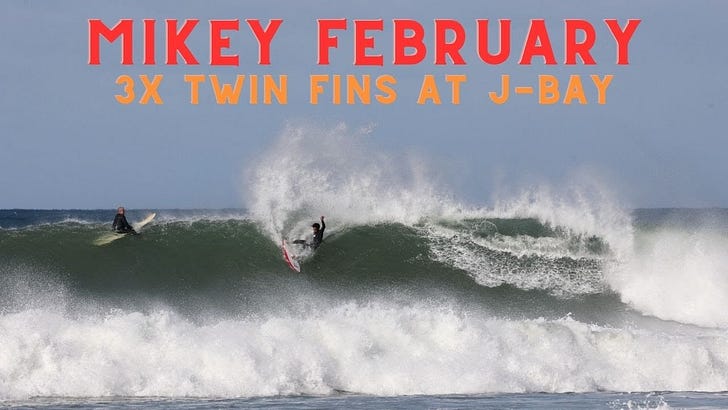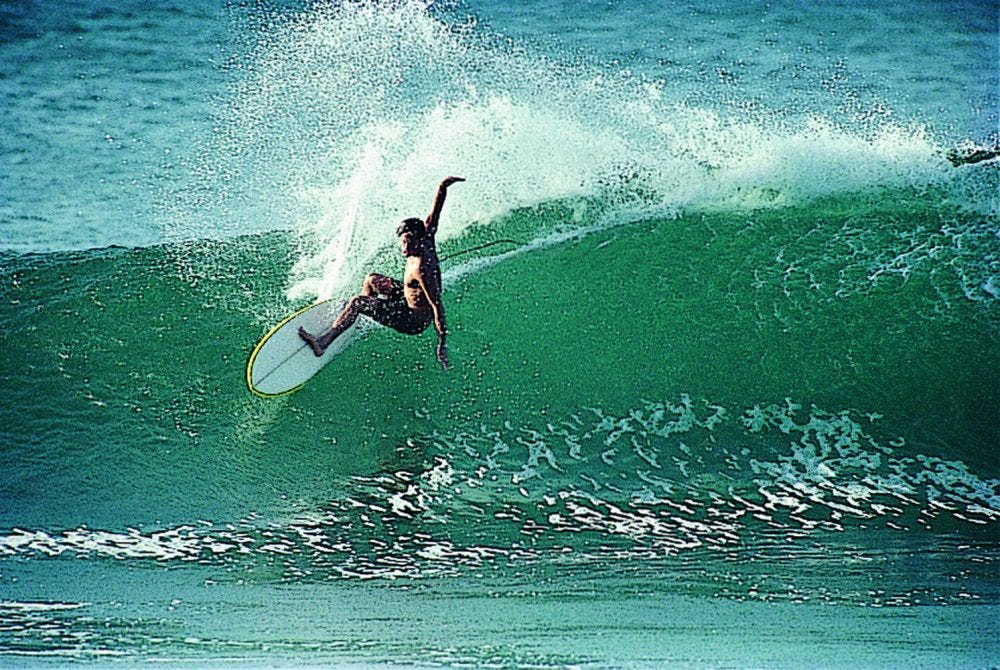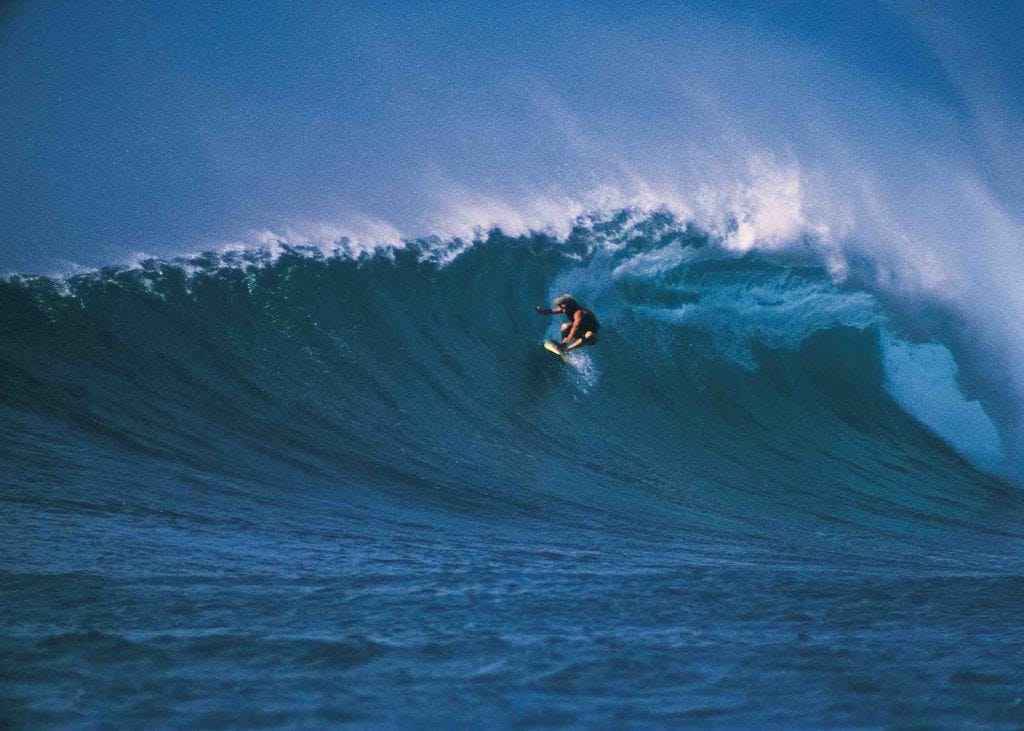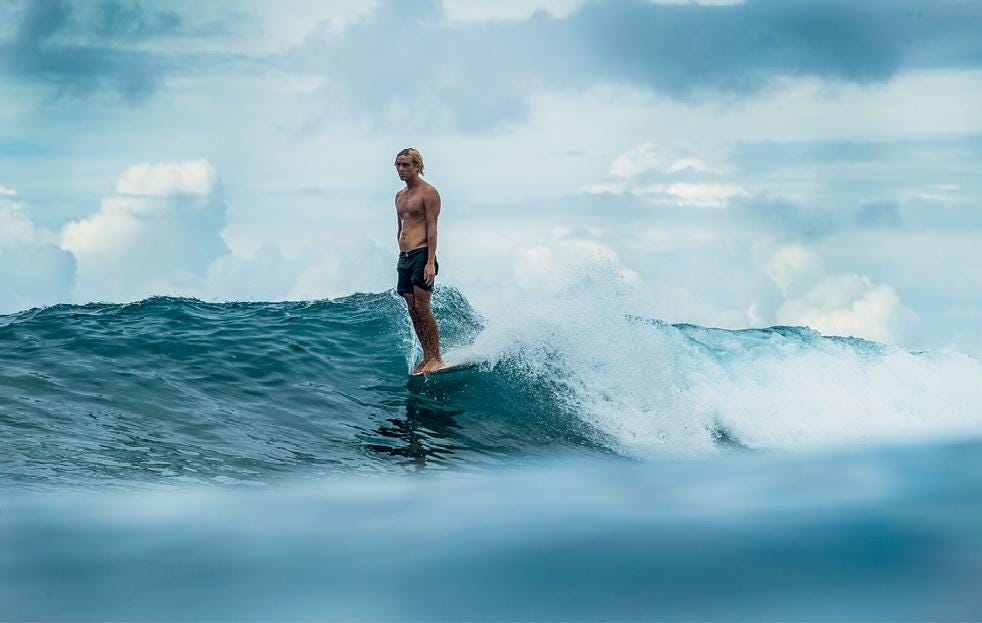Mikey February and the Complications of "Surf Style"
More needs to be said about Mikey February, a 30-year-old South African surfer with a distinctly graceful and fluid approach to the waves. There are more radical surfers out there today, people who do more dynamic “tricks” and bigger airs, but there is no surfer around who is more stylistically refreshing and compulsively watchable.
If you haven’t surfed, or if you have only surfed casually, one surfer’s approach to the waves probably looks more or less like another’s. Or perhaps you might be sensitive to the idea that there are “good” surfers and less good surfers, but not be able to quantify quite what it is that sets the groups apart.
For people who are deeply interested in surfing, the body language of a given rider’s approach to a wave can quite a bit like the unique style of a dancer or a musician — it can be a signature that is instantly recognizable from just a split-second of footage. The most interesting surfers have a body language that is like its own vocabulary of movement.
I grew up on the style gospel of Tom Curren, a surfer from Santa Barbara who had a seemingly effortless, intuitive approach to the waves that was characterized, most of all, by his very expressive use of his hands and arms. Virtually anything Curren in the ocean did looked like Curren, and only like Curren. Yet it never seemed like he was performing in a self-conscious manner; it was simply the way he was. (Photo below by Tom Servais.)
Later, working my way back through the antecedents of this style, I came to appreciate the rest of the surf-world taxonomy: the way 1960’s-era longboarder Phil Edwards held his arms, the way the Hawaiian single-fin wizard Buttons Kahluhiokalani seemed to be able to access virtually any spot on a wave, almost as if physics did not apply to him, the way Terry Fitzgerald’s legs would form almost a ballet-style plié, bowing outward at knees, as he loaded up on speed through an intense section. These guys were all extremely distinct in what they did, all sensitive re-inventors of their craft, even if they did not put it exactly that way. Fitzgerald photo below by Jeff Divine.
Another point of style reference, about whom I have more mixed feelings, is a contemporary rider named Alex Knost, whose choice of surfboards, personal fashion, and repertoire of gestures in the ocean is all very conspicuously “retro” in its affect. I have grudgingly admitted, after many years of resistance, that Knost is quite talented and does interesting things on a surfboard. But the problem I have always had with him is how how conscious he seems to be of what exactly he’s doing. He strikes me a bit like an actor on a stage who, however well he may know the lines, cannot quite manage to disappear into the script he is performing.
Also, uncomfortably (at least to me), Knost’s meticulous emulation of a certain era of white surf culture feels like a cousin of the same sort of thing in the music world: like the rockabilly and neo-country guys who want to pretend that every new day is an idealized, never-changing version of the mid-20th century, never mind what that time was actually like for many people who were not part of the white mainstream. I don’t think Knost means to convey that message through what he does, and that he simply likes what he likes. But I can’t separate those thoughts from my reaction to his surfing — thus my continual sense of unease around what he is up to.
Curren, or Buttons, on the other hand, are/were like actual superheros to me, not a recreation of something from the past. Not guys acting like a thing, or attempting to evoke a a thing, but the thing itself. The O.G. source energy.
February, to my eyes, is another one in that Curren/Buttons mold. A new superhero who has somehow tapped into his own current of something elemental by going forward rather than backwards. He looks fully present in what he is doing, such that he is able to be playful and casual in his choices. In recent years, he also mostly been riding slightly longer/fuller surfboards and twin fin surfboards that allow for a somewhat drawn out and skatey approach to waves. But there is nothing weak or halfhearted or affectedly “retro” in what he does. In the Jeffrey’s Bay footage above, February simply blazes across the wave, carving massive swoops across the face, but he does so with a native casualness that never allows what he is doing to look like hard work.
February is not the only guy who is following this general trajectory. Torren Martyn and Asher Pacey have a somewhat similar approach,and Josh Kerr also does incredible things on twin-fins. If I’m captivated by February it’s not because he’s necessarily better than any of these other guys, but just because he’s so nice in the way he does what he does.
February is 6’3”. When he surfs, he looks tall. He looks lanky and loose. His approach to a wave involves a stance that more closely resembles standing calmly, with the feet somewhat close together,than is typical in “high performance” surfing, where the feet tend to be a bit wider apart. His knees are usually bent, his upper body is calmly erect, and his arms often hanging from the shoulders, except in the moments when his arms come up to accent a turn. It’s a quiet method, restrained and elegant, but simultaneously extremely effective.
Finally, of course, there is the fact that February is black and hails from South Africa instead of being white and from Newport Beach or San Clemente. What’s more, February owns that background and is willing to take on that mantle of representation, at least to a degree: he wore the number 54 in competition as a nod to the countries of the African continent and has highlighted some African breaks and musicians such as Madala Kunene in video projects put out in collaboration with Vans.
This is an important thread in the story simply because the face of surfing, as presented by the surf industry, has been so blandly white for so many decades — and, simultaneously, the depiction of people of color in the surf industry has been so tediously reductive. From Bruce Brown to the present day, the surf-film segment involving “local brown/black kids doing something goofy on the beach while the white visitors rip up the waves that the locals have never noticed are amazing” is a cringe-inducing shtick. It’s a bit that gets recycled over and over again with seemingly no hesitation, as if the colonial overtones of the entire thing were not just a millimeter beneath the surface. The folks who made these films did not feel uncomfortable about framing things that way because they saw themselves as the heros of the story, the masters of the universe. But that story was never remotely complete; it was merely convenient for the people working hard to turn a sport into a commodity.
Watching February surf, one can sense that old narrative gradually crumbling. February is not the comic relief, he is not on the margins of anything. Instead, just by being who he is in the classic Curren manner, February has instinctively positioned himself at the center of a different, and considerably more interesting, story about what surfing means now.







